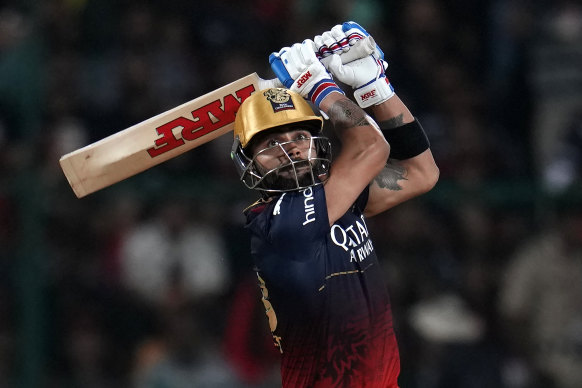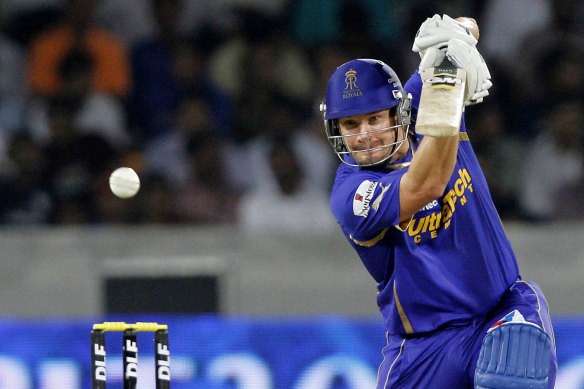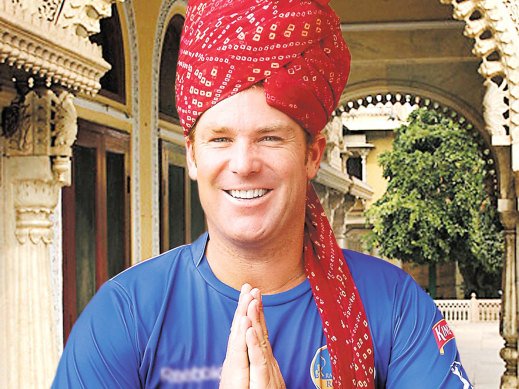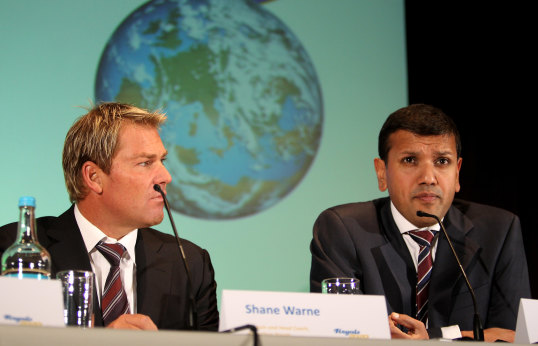‘If the IPL rises, we rise’: How Lachlan Murdoch was sold on cricket’s showbiz behemoth
By Daniel Brettig
When Manoj Badale was convincing Lachlan Murdoch to buy into the nascent Indian Premier League in 2008, he explained to Rupert’s son why this was not exactly a huge gamble.
“I remember saying to Lachlan the night before we bid, don’t think about this as buying a sports franchise, think about this as buying 6 or 7 per cent of the IPL,” said Badale, owner of the Rajasthan Royals, at the recent SportNxt conference in Melbourne.
“If the IPL rises, then we rise, if it doesn’t then we don’t. We’re co-investing with the BCCI [Board of Control for Cricket in India] and with some of the most powerful entities in India.”
Indian superstar Virat Kohli in action in the IPL.Credit:AP
Fifteen years later, having held ownership of the Royals through plenty of scrapes, but enormous revenue growth, Badale now sees ownership of an IPL club as something like that of a major film studio – only with greater benefits.
Independent valuations of IPL clubs sat at around $US67 million apiece in 2009, a figure that has grown to more than $US1 billion ($1.5 billion) each in 2023. Rajasthan’s rise has been embossed by the purchase of a 16 per cent stake in the club by RedBird Capital, famously aligned with the Boston Red Sox and Liverpool FC, for a little over $US200 million.
“You’ve got infinite digital content, but I don’t have to pay the scriptwriters, I don’t really have to pay the actors anymore, and the more creative my content teams are, the more opportunities there are,” Badale said.
The Age and The Sydney Morning Herald have spoken to players, their agents, administrators and others involved in the business of cricket about the IPL’s growing dominance, which is shaping up to be the most profound change to the sport since Kerry Packer’s World Series Cricket upheaval in the late 1970s.
The IPL-as-showbiz metaphor is fitting for a league that is now the financial behemoth of cricket, hauling in broadcast rights fees more or less double that commanded by the world cups. The combination of cricket with Bollywood was part of how the IPL started with a bang, and its place as a mass entertainment vehicle for India and the rest of the cricket world is reshaping the sport with ever-quickening speed.
Sundar Raman, the league’s inaugural chief executive, is now a consultant for Mumbai Indians’ parent company, the Chennai Super Kings, and also the new South Africa Twenty20 league, which has six franchises all owned by IPL conglomerates. He sees the success of the IPL as that of catching a wave at the right moment.
“We caught the wave early, before we were seen as laggards of the sport,” he says. “What the IPL has done is not measured in the simple terms of money or talent. It is the relevance of sport in today’s society and the relevance of cricket to today’s society at large.
“If you look at it bereft of IPL or T20 cricket, cricket would have struggled to play catch-up. The IPL seized momentum and landed cricket into the middle of the wave. What the IPL has been able to do is open up the world to cricket.”
That shift to a more global view is underlined by the expansion of Twenty20 into the United States with Major League Cricket later this year, and the likely inclusion of cricket in the Los Angeles Olympics in 2028. But this is also a story of how the rest of the world has, reluctantly in places, switched its focus to India as the true home of the game.
‘You became one of the locals’
The IPL probably saved Shane Watson’s career. Without a gig for Rajasthan under the captaincy of Shane Warne in 2008, he would likely have struggled to maintain visibility in Australian cricket amid a glut of injuries.
As it was, that inaugural tournament helped him vault back into the Test side that same year. Later, Watson experienced some of the most productive days and nights of his career when he used the IPL to demonstrate a clearer mental approach once his Test days were over.
The IPL arguably saved Shane Watson’s career. Credit:Getty Images
Still involved in the league as an assistant coach for Delhi Capitals, he sums up how it changed things for overseas players in particular.
“India is the epicentre of world cricket – if you want to make it somewhere, you want to perform well in India because that’s where the opportunities lie, potentially for life after cricket, as well with commercial opportunities,” Watson says from Lucknow. “And the beauty of the IPL is you became one of the locals.
“Yes, when you’re playing for your country against India, if you did well, then you’d resonate really well with the Indian public if they enjoyed the way you played. But it went up another level by playing well for a franchise, because you became one of the locals, and it was an incredible feeling to be embraced like that. You’re there, front and centre, every year.”
The influence of those possibilities on options for players, but also on ownership decisions made by other Twenty20 leagues, is enormous. Watson notes the expansion of IPL owners into places such as South Africa, the UAE, the Caribbean and the US with a combination of anticipation and trepidation. No longer is the IPL just a handy end-of-season earner for international cricketers.
“It’s been an incredible win for cricket for sure, up to a point that now it’s changing the landscape,” he says. “The power of the franchises that have been built up over time are now changing the landscape of world cricket. They’re doing that through the strength of the brands, financial clout and power they have in world cricket.
“Certainly for quite a while the IPL was an incredible thing for cricket, and the landscape hadn’t changed much, it was more just an added bonus for cricketers to be a part of. But they are now directing, in some way, the way the world cricket landscape is going. We just need to make sure it is preserving international cricket.”
The late Shane Warne was adopted by the Rajasthan Royals.Credit:Times of India/ Manoj Kesharwani
From 2000 subscribers to 35 million views
There is a useful case study for the rise of India and the IPL in the form of The Grade Cricketer, the irreverent podcast and YouTube channel hosted by Sam Perry and Ian Higgins.
Starting out as a Twitter account focused on the in-jokes and odd behaviours of Sydney grade cricket, it experienced steady growth in the Anglosphere until India’s memorable win over Australia in the Gabba Test in January 2021.
At this point, Perry and Higgins chose to, in cricketing parlance, add another format to their game – putting more time and money into their YouTube channel on the basis that this was the medium through which India’s youthful, cricket-loving audience is primarily engaged.
“The actual take-off for us was after [Indian wicketkeeper-batter] Rishabh [Pant] smashed [Josh] Hazlewood down the ground at the Gabba and we had a fairly nascent YouTube channel at the time,” Perry says. “We recorded a reaction to that moment, which to date is our most viewed video. It starts with ‘Higgos’ swearing wildly, and continues on to us announcing the commencement of the Asian century, and Indians love that.
“When that video happened, we made a really conscious decision to engage as best we could with India, which involved us flying interstate to meet people who could help us learn about the Indian market and to learn about the way of doing things commercially in India.”
While the outcomes have not been entirely linear in terms of commercial return, the numbers themselves are enormous – the YouTube channel has grown from 2000 subscribers to almost 180,000, and views have passed the 35 million mark in a couple of years.
“Many people would assume that results in a commensurate amount of commercial success. That’s wrong,” Perry says. “The Indian consumer on YouTube attracts far less dynamic advertising money.
“But it has afforded us to build enough of a foundation to justify a tour to India a few weeks ago, where we toured six cities and sold out eight live shows.”
A leader in scale, but not innovation
For all its growth, the IPL and Indian cricket more broadly still have a few areas in which to improve their appeal and reach. In a broadcasting sense, coverage retains the conservative bent of the BCCI itself, averse to innovation and independence of thought.
David Hill, the legendary producer and innovator for sports coverage – from the days of World Series Cricket to 21st-century chip technology in ball sports – spoke bluntly of this at SportNxt.
Rajasthan Royals owner Manoj Badale alongside Shane Warne at Lord’s in 2010.Credit:Getty Images
“I’ve never heard of the IPL spoken of as any kind of leader in innovation. All they’ve done is accumulated the production techniques that have been utilised by various countries,” Hill said.
“We are dealing with an age of computerisation and especially the development of chip technology, where I would imagine that you can get computing power to the size of a pinhead. As soon as you do that, it changes the game dynamically and dramatically in terms of golf, cricket and any ball game.
“… But I’ve never seen the IPL as being a world leader in any technology.”
The stadiums reflect the wider gulf between haves and have-nots in India. Corporate hospitality can be as plush as anywhere in the world. But rank-and-file fans deal with chaotic and borderline dangerous experiences straight out of the 1980s English soccer playbook.
An adoring crowd of some 25,000 spectators packed into the Chinnaswamy Stadium in Bengaluru to watch Royal Challengers’ last training session before this year’s edition of the IPL began. But a few days later many of those same fans were injured when caught in a crush for tickets outside the gates.
Packed in like sardines in narrow rows between crush barriers and forced to wait for hours, they were a living example of how much more might be done to look after cricket’s ardent Indian followers.
Nevertheless, India’s scale has also meant the IPL does not have to move first to change the game’s tectonic plates. Earlier this year, the belated launch of a full women’s premier league was a major shift for the game, arraying the world’s best players before huge crowds and a global broadcast audience.
Australian players, who had agitated for the advent of the WPL for some years, did not come home still annoyed about having waited so long. Instead, they reported a fervent desire to play more Women’s Big Bash League Games at major stadiums in Australia, having felt the rush of an Indian crowd.
‘We’ve just got to hope there’s a semblance of logic’
As for the future, it is difficult to see anything other than a landscape increasingly dominated by the IPL, its owners and the BCCI. In earlier years, there was concern that the IPL itself would expand into a season the length of the NBA or Major League Baseball.
While those concerns have receded somewhat, the new scenario is for multiple clubs owned by IPL giants to hoover up players from international cricket. There is, according to the International Cricket Council’s chair Greg Barclay, a sense that the chance for true global collaboration may have already been lost.
“We don’t have the ability, short of everyone getting together,” he says. “The members can talk, but they’re not necessarily totally in control of their own leagues, if they’ve sold them off or licensed them off. There are more than just the boards and the ICC to have those conversations.
“In part, that narrative is lost to us – we’ve just got to hope that there’s a semblance of logic and common sense in the conversation to ensure the goose that lays the golden egg is not going to end up having its neck wrung.”
The squeeze on Test cricket, especially, has already begun. Badale has predicted that over the next decade, the long form may come to be played by just five nations – Australia, England, India, South Africa and New Zealand – while Twenty20 expands into the Olympics and greater global prominence.
Cricket Australia’s chief executive, Nick Hockley, does not differ enormously from that outlook, although he couches it in more optimistic terms.
“We’ve seen from the last two tours out here how much India cares about Test cricket; we also have seen how much they put into world cups and we’ll see that again in October and November this year when they host,” Hockley says.
“So I think that is the quid pro quo for them having their own window in the calendar, that they’re absolutely committed to international cricket, both bilateral and world cups … The other thing is, it also provides a showcase in cricket’s biggest market for the best players in the world, which in turn enhances their brands when they turn out for their various countries against India or in world cups.”
Is there a future like that for cricket?
For Sundar, though, the prospect of a greater Indian and IPL hegemony is something like the natural evolution of a market where 85 per cent of its eyeballs and revenues emanate from the world’s second-most populous nation. Asked whether an increased IPL salary cap would undermine international cricket, he offers the following riposte.
“How come nobody ever says that about the NBA – no one ever says in the world of basketball, Lithuania or Estonia or Spain or Portugal is not becoming a stronger nation because they’re paying truckloads of money so players are drifting towards the US to play?” he asks. “It’s also got to do with how the structures were established.
“Cricket was established as a nation versus nation structure. Whereas the NBA, has it helped grow the game of basketball? Yeah. Has the Premier League helped to grow football? Yeah. The England football team does not play together often, or the Socceroos, but when they do, the whole country is cheering. To play devil’s advocate, is there a future like that for cricket?”
As far as Badale is concerned, ownership of an IPL franchise also comes with responsibilities. He is an advocate for the BCCI allowing Indian players to play in overseas Twenty20 leagues, for instance. And as he wrote in his book A New Innings, the future depends very much on India’s relationship with the rest of the cricket world.
“Most accept that India is the ‘New Home’ of cricket, but how productively India interacts with the rest of the cricketing world will be a central issue,” he wrote. “Collaboration and productive partnerships, with simplified schedules will ultimately benefit all – but require compromise. The rest of the cricket world’s partnership with India is a huge issue for the game.”
Tomorrow: After the IPL and Twenty20 take their share, what’s left for international cricket?
News, results and expert analysis from the weekend of sport sent every Monday. Sign up for our Sport newsletter.
Most Viewed in Sport
Source: Read Full Article




